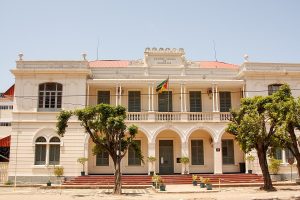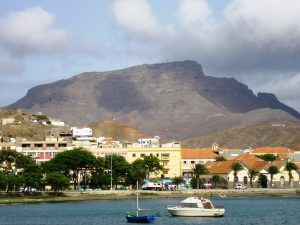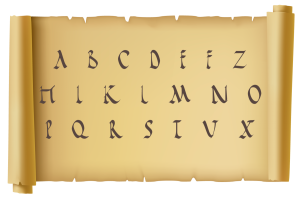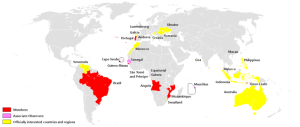1 O MUNDO LUSOFONO E EU
THE LUSOPHONE WORLD AND I

Learning Objectives
In chapter O mundo lusófono e eu, students will learn:
- the alphabet – o alfabeto
- introductions;
- salutations;
- forms of treatments;
- subject pronouns;
- the verb to be;
- nouns;
- adjectives;
- vocabulary pertaing to the classroom;
- basic commands;
- interrogative words;
- days of the week and
- the months of the year.
Portuguese Speaking Countries
The CPLP, Comunidade dos Países de Língua Portuguesa (Community of Portuguese Speaking Countries) is composed of the following nations, in alphabetical order:
Angola, Brazil, Cape Verde, East-Timor, Guinea-Bissau, Mozambique, Portugal and Sao Tome and Principe
Figure 1. World map showing country members of CPLP in red color, observing countries in purple color, and candidate member countries of CPLP in yellow color.
“A história e os objetivos da Comunidade dos Países de Língua Portuguesa” by TVBrasilGov is licensed under CC BY-ND 2.0.

Rio de Janeiro (informalmente referido como Rio)[7] é um município brasileiro, capital do estado homônimo, situado no Sudeste do país. Maior destino turístico internacional no Brasil,[8] da América Latina e de todo o Hemisfério Sul (em 2008),[9] a capital fluminense é a cidade brasileira mais conhecida no exterior,[10] funcionando como um “espelho”, ou “retrato” nacional, seja positiva ou negativamente. É a segunda maior metrópole do Brasil (depois de São Paulo), a sexta maior da América e a trigésima quinta do mundo. Sua população estimada pelo IBGE para o censo de 2022 era de 6 211 423 habitantes.[1] Tem o epíteto de Cidade Maravilhosa,[11] e os que nela nascem são chamados de cariocas. (https://pt.wikipedia.org/wiki/Rio_de_Janeiro)

Lisboa é uma cidade e município, capital de Portugal e da Área Metropolitana de Lisboa. Tem uma área urbana de 100,05 km² e em 2021 tinha 545 796 habitantes[1] (densidade: 5 455,2 hab./km²), sendo a maior cidade do país. É o centro político de Portugal, sede do governo e da residência do chefe de Estado. A Comunidade dos Países de Língua Portuguesa (CPLP) tem a sua sede na cidade e é a capital mais a ocidente do continente europeu, na costa atlântica. Lisboa é considerada como cidade global devido à sua importância em termos financeiros, comerciais, mediáticos, artísticos, educacionais e turísticos.[2][3] É um importante centro económico do continente europeu, graças a um progresso financeiro crescente favorecido pelo maior porto de contentores da costa atlântica da Europa[4] e mais recentemente pelo Aeroporto Humberto Delgado, que recebe mais de 20 milhões de passageiros anualmente (2015). Lisboa conta com uma rede de autoestradas e um sistema de ferrovias de alta velocidade (Alfa Pendular), que liga as principais cidades portuguesas à capital.[5] (https://pt.wikipedia.org/wiki/Lisboa)

Luanda é a capital e a maior cidade de Angola. Localizada na costa do Oceano Atlântico, é também o principal porto e centro económico do país. Constitui um município subdividido em seis distritos urbanos[3] e é também a capital da província homónima. Foi fundada a 25 de Janeiro de 1576 pelo fidalgo e explorador português Paulo Dias de Novais, sob o nome de “São Paulo da Assunção de Loanda”.[4][5] Com um perfil extremamente cosmopolita, os habitantes de Luanda são, na sua maioria, membros dos grupos étnicos ambundos, congos e ovimbundos, existindo frações relevantes de todas as origens étnicas angolanas. Existe uma população de origem europeia, constituída principalmente por portugueses, estimada em cerca de 400 mil pessoas. Há também uma importante comunidade chinesa estimada em 67 mil. A língua oficial e a mais falada é o português, sendo também faladas várias línguas africanas. Luanda foi a principal cidade a acolher os jogos do Campeonato Africano das Nações 2010. (https://pt.wikipedia.org/wiki/Luanda)

Maputo é a capital e a maior cidade de Moçambique. É também o principal centro financeiro, corporativo e mercantil do país. Localiza-se na margem ocidental da baía de Maputo, no extremo sul do país, perto da fronteira com a África do Sul e, da fronteira com o Essuatíni e, por conseguinte, da tripla fronteira dos três países. Fundada no século XVI, serviu como o principal entreposto português naquele ponto do oceano Índico, graças à sua baía privilegiada, tornando-se, em 1898, a capital da colónia; até 13 de março de 1976, a cidade era denominada “Lourenço Marques” em homenagem ao explorador português homónimo. (https://pt.wikipedia.org/wiki/Maputo)

Mindelo é uma cidade que se localiza na ilha de São Vicente, é sede do concelho homónimo e é a segunda maior cidade de Cabo Verde. Ocupa uma área total de 67 km² a noroeste da ilha, na Baía do Porto Grande, porto natural formado pela cratera submarina de um vulcão com cerca de 4 km de diâmetro. O Ilhéu dos Pássaros, com 82 metros de altitude e que hospeda um pequeno farol, sinaliza a outra extremidade da cratera. Em Mindelo respira-se uma atmosfera muito própria e um ar cosmopolita trazido pelo Porto Grande. Esta atmosfera única é indissociável do calor humano e da hospitalidade das suas gentes. É a sua faceta de cidade amante do lado divertido da vida que lhe confere o rótulo de capital da diversão do país: bons restaurantes, frequentes animações com música ao vivo e, sobretudo, uma agradável convivência que a sua gente procura e cultiva. Ao clima ameno, pautado por uma temperatura suave, juntam-se o arranjo cuidado dos lugares públicos, o património histórico bem preservado e um movimento cultural permanente. É talvez esta multiplicação de manifestações de vivacidade que levam a considerá-la a cidade mais acolhedora e atraente do país. Há quem diga que aqui nasceu a morabeza e aqui continua a ser a sua sede. (https://pt.wikipedia.org/wiki/Mindelo_(Cabo_Verde))
Warm up questions:
- What do you know about the Portuguese speaking world?
- Can you name some athletes, singers, performers, artists or musicians that come from a Portuguese speaking country?
- Can you name some cities and/or tourist attractions in the Portuguese speaking world?
THE ALPHABET- O Alfabeto
A (a)
B (bê)
C (cê)
D (dê)
E (ê)
F (efe)
G (gê)
H (aga)
I (i)
J (jota)
K (ka)
L (ele)
M (eme)
N (ene)
O (o)
P (pê)
Q (quê)
R (erre)
S (esse)
T (tê)
U (u)
V (vê)
W (dabliu)
X (xis)
Y (ypsilon)
Z (zê)
Key Takeaways
Although officially the Portuguese alphabet shows all 26 letters, K, W and Y are not used in the Portuguese language lexicon, except for names.
EXERCISES
Working with a partner, take turns asking and answering the following questions:
- How do you spell your name (nome)?
- How do you spell your last name (sobrenome)?
- Listen to the following 2 tongue twister and try writing them down:
BOM DIA, BOA TARDE and BOA NOITE
In Portuguese, “Bom dia,” “Boa tarde,” and “Boa noite” are greetings used to wish someone a good day, a good afternoon, and a good evening/night, respectively.
These expressions also show respect and are very often used instead of “Hi” (Oi) when innitiating a conversation, either in person, by phone or via text.

Bom dia is typically used in the morning, between 6:00 a.m. and 11:59 a.m.
Bom dia is used in Portuguese as a way to greet someone and wish them a good start to their day.
Boa tarde is typically used in the afternoon, between 12:00 p.m. and 6:00 p.m.
Boa tarde is also a way to greet someone and wish them a good afternoon.

Boa noite is typically used in the evening, after 6:00 p.m.
Boa noite is also used as a way to greet someone and wish them a good night.
USEFUL WORDS
-
-
- bem vindo/a (welcome)
- bom dia (good morning)
- boa tarde (good afternoon)
- boa noite (good evening/good night)
- obrigado/a (thanks/thank you)
- de nada (you’re welcome)
- com licença (excuse me)
- desculpe (excuse me/sinto muito)
- que pena (what a pity)
- sinto muito (I’m sorry)
- por favor (please)
- igualmente (dido/same)
- prazer/muito prazer (my pleasure/pleasure to meet you)
-
EXERCISES
Match the greeting with the correct time of day (“Bom dia,” “Boa tarde,” and “Boa noite”):
- São 11 horas da manhã. ___________________________________
- São 18 horas. ___________________________________________
- São 9 horas. ____________________________________________
- São 2 horas da manhã. ____________________________________
Write down the words you hear:
- _________________________________
- _________________________________
- _________________________________
- _________________________________
- _________________________________
- _________________________________
- _________________________________
- _________________________________
- _________________________________
- _________________________________
Role-play:
- Pair up with a partner and take turns greeting each other using “Bom dia,” “Boa tarde,” and “Boa noite” at different times of the day. Practice using the greetings in different social situations, such as at work, at a store, at a restaurant, etc.
Write a conversation:
Write conversations that includes all three greetings, “Bom dia,” “Boa tarde,” and “Boa noite.” Make sure to use the correct greeting for the time of day in the conversation.
Música: Jorge Ben Jor “Que Pena:”
Música: Michel Teló “Ai Se Eu Te Pego”
Key Takeaways
Bom dia, boa tarde and boa noite are a very important part of Portuguese language social etiquette. They are used as a way to show consideration and respect for others, and to start a conversation in a friendly and polite manner. These expressions can be used in both formal and informal situations.
OBRIGADO, OBRIGADA and DE NADA
The word thanks, or the expression thank you are considered gendered words in Portuguese. That means that they assume the gender of the person who says it, as they literally translate as I am obliged to you.
If you identify as male, say OBRIGADO.
If you identify as female, say OBRIGADA.
A gender neutral way of expressing thanks is to say OBRIGADE.
The answer is DE NADA.
Música: Titãs “Obrigado”
INTRODUCTIONS AND FORMS OF TREATMENT
When greeting, addressing and introducing someone in Portuguese, there are different degrees of formality, depending on settings (familiar, academic or professional), regional differences (Brazilian or European Portuguese), the gender your interlocutor identifies with, and whether you are addressing one or more than one person.
The words for you when addressing one person can be tu, você, o senhor (masculine, singular) and a senhora (feminine, singular).
The words for you when addressing more than one person can be vocês, os senhores and as senhoras.
Key Takeaways
In Portugal and Lusophone African countries, TU is a gender neutral pronoun used to address one person in a familiar setting. VOCÊ is considered a more formal, gender neutral form of treatment, and O SENHOR and A SENHORA are gendered words used to show hierarchy or respect towards the person being addressed. Similarly, the same ideas apply to VOCÊS (gender neutral), OS SENHORES (masculine) and AS SENHORAS (feminine) when addressing more than one person.
In most of Brazil, VOCÊ is a gender neutral pronoun used to address one person in a familiar setting. Some Brazilian regions, like Rio de Janeiro, Northeastern states such as Pernambuco and Rio Grande do Sul in the south, use TU, although in spoken settings it is often used with the verb conjugation used for VOCÊ . The expressions O SENHOR and A SENHORA are considered formal gendered forms of treatment used to indicate hierarchical rank or respect. Similarly, the same ideas apply to VOCÊS (gender neutral), OS SENHORES (masculine) and AS SENHORAS (feminine) when addressing more than one person.
Here’s a simple, present tense, INFORMAL greeting, introduction and salutation dialogue in Brazilian Portuguese. Notice how they address each other using “você:”

Maria: Oi, bom dia! Como você está hoje? (Hello! How are you today?)
João: Bom dia, estou bem, obrigado. E você? (I’m fine, thank you. And you?)
Maria: Estou ótima, obrigada. (I’m great, thank you.)
João: Qual é o seu nome? (What’s your name?)
Maria: Meu nome é Maria. E o seu? (My name is Maria. And yours?)
João: Meu nome é João. Prazer em conhecer você. (My name is João. Nice to meet you.)
Maria: Igualmente, João. (Likewise, João.)
Here is a simple, present tense, FORMAL greeting, introduction and salutation in Brazilian Portuguese. Notice how they address each other in a formal way, using “o senhor” and “a senhora” instead of “você:”

Dona Maria: Olá, boa tarde! Como vai o senhor? (Good afternoon! How are you?)
Senhor João: Bem, obrigado. E a senhora? (Well, thank you. And you?)
Dona Maria: Estou bem, obrigada. (I’m well, thank you.)
Senhor João: Qual é o nome da senhora, por favor? (What’s your name, please?)
Dona Maria: Meu nome é Maria Silveira. (My name is Maria Silveira.)
Senhor João: É um prazer conhecer a senhora. Eu sou o João dos Santos. (Nice to meet you, Mrs. Maria. I’m João dos Santos.)
Dona Maria: É um prazer conhecer o senhor também, Seu* João. (Nice to meet you too, Mr. João.)
Key Takeaways
*”Seu” is an informal way of addressing someone in Portugal and in some regions of Brazil to show respect, usually in non-official or informal situations.
“Senhor“, on the other hand, is a more formal way of addressing someone, used in formal situations, such as in the workplace, social events, etc. It is a respectful way of referring to an older man or to someone in a position of authority.
The choice between “seu” and “senhor” depends on the context of the situation and the relationship between the individuals involved. Generally, using “seu” shows more familiarity and intimacy, while using “senhor” shows more formality and respect.
SUBJECT PRONOUNS
Subject pronouns and forms of teatment in European and Brazilian Portuguese are mostly the same, and they are used to indicate who is performing the action in a sentence. They include:
-
-
-
-
Eu (I)
-
Tu (singular, informal You) – used in Portugal and Lusophone Africa
-
Você (singular, informal You) – used in Brazil
-
O senhor (singular, formal You)
-
A senhora (singular, formal You)
-
Ele (He)
-
Ela (She)
-
Nós (We)
-
A gente (Informal We)
-
Vocês (plural you)
-
Os senhores (plural, masculine, formal You)
-
As senhoras (plural, feminine, formal You)
-
Eles (They, masculine)
-
Elas (They, feminine)
-
-
-
It is important to understand the different subject pronouns in Portuguese and when to use each one, as the choice of pronoun affects the form of the verb in a sentence, and can change the level of formality and the relationship between the speaker and the person being addressed.
Review of “You”
“You” in Brazilian Portuguese:
“Você” is the informal singular pronoun for “you” in Portuguese. It is used to address someone who is familiar, such as a friend, relative, or someone of the same age or social status. The use of “você” is common in everyday conversations and can convey a sense of informality and intimacy.
In contrast, the formal singular pronoun for “you” in Portuguese is “o senhor/a senhora,” which is used to address someone who is older, in a position of authority, or someone with whom one has a formal relationship.
It’s important to note that the choice of pronoun can have a significant impact on the tone and formality of a conversation, so it’s important to be mindful of the social context and the relationship between the speakers when using either “você” or “o senhor/a senhora”.
Using inclusive language and neutral pronouns in Portuguese
In Portuguese, “pronomes neutros” refer to neutral pronouns. These are pronouns that do not specify the gender of the person being referred to, and are used when the gender is unknown or not specified.
The neutral pronoun in Portuguese is “elix” (he), which can be used to refer to both male and female individuals. For example:
- “Ele está procurando um emprego.” (He is looking for a job.)
- “Elix/Elus é muito inteligente.” (He/She is very intelligent.)
It’s worth noting that the use of “elix” or “elus” as a neutral pronoun is a relatively recent development in Portuguese, and some speakers may prefer to use “ele” only to refer to males, and “ela” (she) to refer to females. In these cases, the gender-neutral pronoun “a pessoa” (the person) may be used instead.
Overall, the use of neutral pronouns in Portuguese can vary depending on the region and the speaker, so it’s important to be mindful of the context and the preferences of the person being addressed when using neutral pronouns.
Inclusive language in Portuguese
Inclusive language in Portuguese refers to language that is non-discriminatory and respectful of all individuals, regardless of their gender, ethnicity, sexual orientation, or any other characteristic that may lead to discrimination.
In Portuguese, the use of inclusive language involves avoiding the use of language that reinforces gender stereotypes or excludes certain groups of people. For example, using gender-neutral pronouns (such as “eles” and “elas” instead of “ele” for both males and females) and avoiding gendered language (such as “homem” for man and “mulher” for woman) in job titles and other professional contexts can help create a more inclusive language environment.
Inclusive language is an important aspect of promoting equality and respect for all individuals, and it can play a significant role in challenging and changing attitudes that lead to discrimination and marginalization. By using inclusive language, speakers can help create a more inclusive and respectful society, where everyone feels valued and heard.
Inclusive language in Portuguese refers to language that is non-discriminatory and respectful of all individuals, regardless of their gender, ethnicity, sexual orientation, or any other characteristic that may lead to discrimination.
In Portuguese, the use of inclusive language involves avoiding the use of language that reinforces gender stereotypes or excludes certain groups of people. For example, using gender-neutral pronouns (such as “eles” and “elas” instead of “ele” for both males and females) and avoiding gendered language (such as “homem” for man and “mulher” for woman) in job titles and other professional contexts can help create a more inclusive language environment.
Inclusive language is an important aspect of promoting equality and respect for all individuals, and it can play a significant role in challenging and changing attitudes that lead to discrimination and marginalization. By using inclusive language, speakers can help create a more inclusive and respectful society, where everyone feels valued and heard.
Addressing a non-binary person in Portuguese can be challenging, as there is currently no widely recognized set of non-binary pronouns in the language. However, here are a few ways to be respectful and inclusive when addressing non-binary individuals in Portuguese:
- Use their name: One of the simplest and most respectful ways to address a non-binary person is to use their name. This avoids the use of any pronouns that may not align with their gender identity.
- Use gender-neutral language: If the person’s gender identity is unknown or if they prefer gender-neutral language, you can use the gender-neutral pronoun “a pessoa” (the person) or “eles/elas” (they).
- Ask for their preferred pronoun: If you’re not sure how to address a non-binary person, it’s always a good idea to ask them what pronoun they prefer. This shows that you respect their identity and are willing to use language that aligns with their gender.
Key Takeaways
It’s important to note that non-binary individuals may have different preferences for how they want to be addressed, so it’s always best to ask and respect their choice. By using language that is respectful and inclusive, we can help create a more accepting and understanding society for all individuals.
VERB SER (to be)
The verb “ser” is one of the two most important verbs in Portuguese, the other being “estar.”
The verb “ser” is used to express the following permanent or inherent qualities or characteristics of a person, place, or thing, such as:
- innate or intrinsic qualities or characteristics
- identity
- gender
- origin
- occupation
- religion
- nationality
- marital status
The verb “ser” is not used to describe temporary or situational conditions, for which “estar” is used instead.
Here are some examples of using the verb “ser” in Portuguese:
- Eu sou brasileiro/a. – I am Brazilian.
- Tu és estudante. – You (informal, Pt, LA) are a student.
- Você é estudante. – You (informal, Br) are a student.
- O senhor é professor? – Are you (formal, masculine) are a professor/teacher?
- A senhora é professora. – You (formal, feminine) are a professor/teacher.
- Ele não é médico? – Isn’t he a doctor?
- Ela não é médica. – She is a doctor.
- Nós somos amigos. – We are friends.
- Vocês são de Portugal .– You (formal, plural) are from Portugal.
- Os senhores são de Cabo Verde? – Are you (formal, plural, masculine) from Cape Verde?
- As senhoras são de Cabo Verde? – Are you (formal, plural, masculine) from Cape Verde?
- Eles não são engenheiros. – They (masculine) are engineers.
- Elas não são engenheiras. – They (feminine) are engineers.
Key Takeaways
Note that the conjugation of “ser” changes according to the subject pronoun, just like any other verb in Portuguese. It is important to understand the difference between “ser” and “estar” in Portuguese, as their usage affects the meaning of a sentence.
The present tense conjugation of the verb “ser” in Portuguese is as follows:
-
-
-
-
-
- Eu sou (I am)
- Tu és (You are)
- Você é (You are)
- O senhor é (You are)
- A senhora é (You are)
- Ele é (He is)
- Ela é (She is)
- Nós somos (We are)
- Vocês são (You all are)
- Os senhores são (You all are)
- As senhoras são (You all are)
- Eles são (They are)
- Elas são (They are)
-
-
-
-
DESCRIPTIVE WORDS IN PORTUGUESE
Here is a list of some common descriptive adjectives in Portuguese. These adjectives can be used to describe people, places, or things. They provide more information about the noun they modify and help to create a vivid and interesting description.
Note that adjectives in Portuguese are gendered, i.e.; they follow the gender of the person who is being described (ending in –o for masculine, and –a for feminine. Non-binary adjectives end in –ix).
Adjective words not ending in –a or –o are considered gender neutral.
Adjectives must also agree with the people they are describing in terms of number, i.e.; singular or plural. For adjectives ending in -a, -o, or -e, simply add -s to form the plural. (We will study the plural form of words ending in consonants late in this chapter).
-
-
-
-
-
- Alto(a) – tall
- Baixo(a) – short
- Bonito(a) – beautiful, pretty, handsome
- Cansado(a) – tired
- Contente – happy
- Delicado(a) – delicate
- Doente – sick
- Fácil – easy
- Difícil – difficult, hard
- Feliz – happy
- Forte – strong
- Frio(a) – cold
- Gostoso(a) – delicious
- Grande – big, large
- Pequeno(a) – small
- Inteligente – intelligent
- Jovem – young
- Leve – light
- Pesado(a) – heavy
-
-
-
-
-
-
-
-
-
- Lindo(a) – beautiful
- Pequeno(a) – small
- Quente – hot
- Frio/a– cold
- Rápido(a) – fast
- Lento/a – slow
- Sério(a) – serious
- Simpático(a) – friendly
- Antipático/a – mean/unpleasant
- Sóbrio(a) – sober
- Triste – sad
- Alegre – happy
- Velho(a) – old
- Bonito(a) – pretty, handsome, beautiful
- Brilhante – brilliant
- Calmo(a) – calm
- Carinhoso(a) – affectionate
- Caro(a) – expensive
-
-
-
-
-
-
-
-
-
- Barato(a) – cheap
- Claro(a) – clear
- Compreensivo(a) – understanding
- Confiante – confident
- Corajoso(a) – brave
- Criativo(a) – creative
- Delicado)a – delicate
- Educado(a) – polite
- Elegante – elegant
- Engraçado(a) – funny
- Divertido(a) – amusing
-
-
-
-
-
-
-
-
-
- Exigente – demanding
- Expressivo(a) – expressive
- Fiel – faithful
- Forte – strong
- Fraco(a) – weak
- Generoso(a) – generous
- Gentil – kind
- Rico(a) – rich
- Pobre – poor
- Extrovertido(a) – extroverted
- Introvertido(a) – introverted
- Tímido(a) – shy
- Honesto(a) – honest
- Humilde – humble
-
-
-
-
-
-
-
-
-
- Interessante – interesting
- Jovem – young
- Leal – loyal
- Majestoso(a) – majestic
- Preguiçoso(a) – lazy
- Trabalhador/a – hard working
-
-
-
-
Key Takeaways
These adjectives can be used to describe people, places, or things. They provide more information about the noun they modify and help to create a vivid and interesting description.
EXERCISES
-
Working with a partner, take turns describing yourselves.
-
Describe the people you see in these pictures using the grammar and vocabulary learned in this chapter.






3. Complete these sentences with the correct conjugation of the verb SER:
Eu ___________ americano/a.
Nós ____________ muito inteligentes.
Você __________ tímido/a?
Ela não __________ preguiçosa.
Vocês ____________ honestos/as?
Ele ____________ um pouco engraçado.
Eles _____________ interessantes.
Elas ____________ interessantes.
VERB ESTAR (to be)
In Portuguese, the verb “estar” is an auxiliary verb that is used to describe temporary states, conditions, and feelings.
Unlike the verb “ser,” which is used to describe permanent or inherent characteristics, “estar” is used to describe something that is happening or changing at the moment.
Here are some common uses of “estar” in Portuguese:
-
-
- Physical location: To describe where someone or something is, you can use “estar” with the preposition “em” (in). For example: “Ele está em casa” (He is at home).
-
-
-
- Emotional state or temporary condition: To describe someone’s emotional state, you can use “estar” with adjectives. For example: “Ela está feliz?” (She is happy). “Nós não estamos cansados” (We are not tired).
-
-
-
- Progress or development: To describe something that is happening or changing, you can use “estar” with verbs such as “crescendo” (growing), “melhorando” (improving), or “piorando” (worsening). For example: “O clima está piorando” (The weather is getting worse).
-
-
-
- Health: To describe someone’s health, you can use “estar” with adjectives such as “bem” (well) or “mal” (not well). For example: “Eu estou bem” (I’m well).
-
-
-
- Weather: To describe the weather, you can use “estar” with adjectives such as “frio” (cold), “quente” (hot), or “chuvoso” (rainy). For example: “Hoje está quente” (It is hot today).
-
Key Takeaways
It’s important to keep in mind that “estar” is a flexible verb that can be used in many different contexts, and its meaning can vary depending on the context.
The present tense conjugation of the verb “estar” in Portuguese is as follows:
-
-
-
-
-
Eu estou – I am
-
Tu estás – You (informal) are
-
Você está – You (informal) are
-
Ele/Ela está – He/She is
-
Nós estamos – We are
-
Vocês estão – You (formal) are
-
Eles/Elas estão – They are
-
-
-
-
Here are some examples of the verb “estar” in the present tense:
-
Eu estou feliz. – I am happy at this moment.
-
Tu estás cansado. – You (informal) are tired.
-
A senhora está cansada? – Are you (formal) tired?
-
Ele está com fome? – Is he is hungry?
-
Nós não estamos cansados. – We are tired.
-
Vocês estão com pressa? – Are you (formal) in a hurry?
-
Eles não estão animados. – They are excited.
Key Takeaways
Note that the conjugation of “estar” changes according to the subject pronoun, just like any other verb in Portuguese.
Here are some examples of using the verb “estar” in the present tense to describe location and progress or development:
-
-
-
-
- Eu estou em casa. – I am at home.
- Tu estás na escola? – Are you (informal) are at school?
- Ele não está no parque. – He is not in the park.
- Nós estamos no shopping.– We are at the mall.
- Vocês estão no teatro? – Are you (formal) at the theater?
- Eles estão no bar. – They are at the bar.
- Eu estou falando português. – I am speaking Portuguese.
-
-
-
Exemplo: Música: Titãs “Tô Cansado”
Key Takeaways
Note that when describing location in Portuguese, the preposition “em” is often used with the verb “estar.” This construction (verb + preposition) is commonly used to express where someone or something is.
EXERCISES
1. Complete these sentences with the correct conjugation of the verb ESTAR:
Eu ___________ na faculdade.
Nós ____________ tristes.
Você __________ cansado/a?
Ela não __________ bem.
Vocês ____________ falando inglês?
Ele ____________ chateado.
Eles _____________ em casa?
Elas ____________ trabalhando.
Articles, contractions and prepositions
The words “the,” “a” and “an” are called articles. In Portuguese, these words agree in gender and number to the words that follow them.
-
-
-
THE: (o, a, os, as)
-
-
EXAMPLES: A casa é bonita?
O carro não é caro.
Os estudantes são esforçados.
As meninas são corajosas.
-
-
-
A, AN (um, uma, uns, umas)
-
-
EXAMPLES: Ela tem uma caneta. Elas têm umas canetas.
Você tem um caderno? Vocês têm uns cadernos?
-
-
-
IN and IN THE, ON THE, AT THE (em, no, na, nos, nas)
-
-
EXAMPLES: Eles estão em casa.
A casa está no campo.
Eles estão nos restaurantes na praia.
Os passarinhos estão nas janelas.
-
-
-
OF THE, FROM THE (do, da, dos, das)
-
-
EXAMPLES: Eu sou do Brasil.
Você é de Portugal?
Nós não somos de Angola.
Elas não são da Argentina.
Eles são dos Estados Unidos?
-
-
-
TO THE (para a = à, para o = ao)
-
-
EXAMPLES: Eu vou para a universidade = Eu vou à universidade.
Ele vai para o laboratório = Ele vai ao laboratório.
Diálogo
Ana e Cristina são brasileiras. Ana é do Rio de Janeiro e Cristina é de São Paulo. Elas estão alegres porque são muito amigas e agora estão juntas. Ana é alta e extrovertida. Cristina não é muito alta mas é bastante atlética. Elas conversam sobre as cidades onde moram.
ANA: O Rio é uma cidade grande, como é São Paulo?
CRISTINA: São Paulo é muito grande! A cidade tem um parque enorme chamado Parque Ibirapuera. Também é uma cidade muito moderna. E no Rio, como é?
ANA: O Rio tem muita gente, mas o transporte é um pouco ruim. O Rio tem muitas praias bonitas. Também tem uma floresta urbana chamada Floresta da Tijuca.
CRISTINA: Um dia vamos acampar lá?
ANA: Com certeza!

Key Takeaways
In this dialogue, we learned the following new words and expressions:
- Muito = a lot, very
- Ruim = bad (the opposite of bom/boa = good)
- Pouco/a = a few, little
- Lá = there, over there
- Com certeza = certainly, of course, sure.
CLASSROOM OBJECTS
Objetos da sala de aula
The following vocabulary words are used to identify objects and persons in the classroom. Notice how they are gendered:

-
a mochila
-
a planta
-
o computador
-
o teclado
-
o mouse
-
o relógio
-
o livro
-
o caderno
-
o lápis
-
a caneta
-
a borracha
-
a régua
-
o clipe de papel
-
o prendedor de papel
-
o telefone celular
BASIC COMMANDS – Os Comandos Básicos
Here’s a list of basic commands in Portuguese. These commands cover a range of everyday situations and are useful for everyday communication.
-
-
-
Diga (Say): Used when you want someone to say or tell something.
Example: Diga-me seu nome. (Tell me your name.)
-
Fale (Speak): Similar to “dizer,” it’s used when asking someone to speak or express themselves.
Example: Fale mais devagar, por favor. (Speak more slowly, please.)
-
Escute (Listen): Asking someone to pay attention or listen.
Example: Escute a música, é bonita. (Listen to the music, it’s beautiful.)
-
Leia (Read): Asking someone to read something.
Example: Leia este livro quando puder. (Read this book when you can.)
-
Escreva (Write): Used when you want someone to write something.
Example: Escreva seu endereço aqui. (Write your address here.)
-
Veja (See): Asking someone to see or look at something.
Example: Veja este filme, é muito interessante. (See this movie, it’s very interesting.)
-
Faça (Do): Used when you want someone to do something.
Example: Faça a lição de casa antes de sair. (Do your homework before leaving.)
-
Venha (Come): Inviting someone to come or join you.
Example: Venha jantar conosco. (Come to dinner with us.)
-
Vá (Go): Instructing someone to go or leave.
Example: Vá para casa e descanse. (Go home and rest.)
-
Espere (Wait): Asking someone to wait.
Example: Espere um momento, por favor. (Wait a moment, please.)
-
Abra (Open): Instructing someone to open something.
Example: Abra a porta antes de entrar. (Open the door before entering.)
-
Feche (Close): Instructing someone to close something.
Example: Feche a janela, está frio. (Close the window, it’s cold.)
-
-
INTERROGATIVE WORDS – Pronomes Interrogativos
Portuguese interrogative words are essential for asking questions and seeking information. These interrogative words are crucial for constructing questions in Portuguese, and understanding their usage will help you communicate effectively in various situations. Here’s an explanation of each of them:
-
-
-
Quem (Who):
- Usage: Used to inquire about a person’s identity.
- Example: Quem é o presidente? (Who is the president?)
-
O que (What):
- Usage: Used to ask about things, actions, or ideas.
- Example: O que você está fazendo? (What are you doing?)
-
Onde (Where):
- Usage: Used to ask about a location or place.
- Example: Onde fica a biblioteca? (Where is the library?)
-
Quando (When):
- Usage: Used to inquire about the time or moment of an event.
- Example: Quando é o seu aniversário? (When is your birthday?)
-
Por que (Why):
- Usage: Used to ask about the reason or cause.
- Example: Por que você está chorando? (Why are you crying?)
-
Como (How):
- Usage: Used to ask about the way or manner something is done.
- Example: Como você chegou aqui? (How did you get here?)
-
Quanto/a (How much/many):
- Usage: Used to ask about quantity or price.
- Example: Quanto custa este livro? (How much does this book cost?)
-
Qual (Which):
- Usage: Used to inquire about a specific item or choice among others.
- Example: Qual é a sua cor favorita? (What is your favorite color?)
-
Quais (Which ones):
- Usage: Plural form of “Qual,” used when asking about multiple items or choices.
- Example: Quais são os seus planos para o final de semana? (What are your plans for the weekend?)
-
-
Key Takeaways
In Portuguese, “o que” and “qual” are both used to ask questions, but they are used in different contexts and have different meanings. In summary, “o que” is used for more general or open-ended questions, while “qual” is used for more specific questions where you are selecting from a set of options.
-
“O que“: This is a more general question word and is used to ask about an undefined or unspecified thing or action. It can be translated to English as “what.”
- Example: “O que você está fazendo?” (What are you doing?)
- Example: “O que aconteceu?” (What happened?)
-
“Qual“: This question word is more specific and is used when you are asking about a particular thing or choosing from a limited set of options. It can be translated to English as “which” or “what.”
- Example: “Qual é o seu nome?” (What is your name?) – Here, you are choosing from a set of possible names.
- Example: “Qual é a sua cor favorita?” (What is your favorite color?) – Again, you are selecting from a range of possible colors.
Exercises
Working with a classmate, take turns asking “O que é isso?” Make sure to include the indefinite articles “um,” “uma,” “uns” or “umas.”
- Example: O que é isso? É uma caneta.

MONTHS AND DAYS OF THE WEEK – Os Meses e Os Dias da Semana
The days of the week in Portuguese are:
Segunda-feira: Monday
Terça-feira: Tuesday
Quarta-feira: Wednesday
Quinta-feira: Thursday
Sexta-feira: Friday
Sábado: Saturday
Domingo: Sunday
The months of the year are:
Janeiro: January
Fevereiro: February
Março: March
Abril: April
Maio: May
Junho: June
Julho: July
Agosto: August
Setembro: September
Outubro: October
Novembro: November
Dezembro: December
Os Dias da Semana em Português
Esses são os dias da semana em português, cada um com seu papel único na organização e fluidez de nossas vidas cotidianas.
A semana em português começa com a segunda-feira. É o dia que marca o início da maioria das atividades semanais. As pessoas retornam ao trabalho e à rotina diária, preparando-se para os desafios que a semana trará.
A terça-feira segue, trazendo consigo a energia do começo da semana. As pessoas se dedicam aos seus afazeres, e a semana começa a ganhar ritmo. É um dia para avançar em projetos e compromissos.
Chegamos à metade da semana com a quarta-feira. Conhecida como “quarta-feira” em português, é um momento em que muitos começam a sentir que o final da semana está se aproximando. É também um dia frequentemente associado a reuniões e planejamento.
A quinta-feira representa a antecipação do final de semana. As pessoas começam a fazer planos para o tempo livre que se aproxima. É um dia para finalizar tarefas e garantir que tudo esteja encaminhado antes da sexta-feira.
E então, finalmente, chega a sexta-feira, um dia muito esperado por muitos. Marcando o fim da semana de trabalho para a maioria, a sexta-feira é associada a um clima mais descontraído e à expectativa do merecido descanso do final de semana.
O sábado é um dia dedicado ao lazer e ao tempo livre. As pessoas podem relaxar, aproveitar atividades recreativas e passar momentos especiais com amigos e familiares. É o ápice da semana para muitos.
A semana culmina no domingo, o último dia antes do recomeço. Algumas pessoas veem o domingo como um dia de descanso, enquanto outras o utilizam para se preparar para a próxima semana. É um momento para refletir sobre os dias passados e se preparar para os desafios vindouros.
Os meses do ano em português
Aqui está uma explicação breve de cada mês em português. Essas palavras refletem as influências históricas e culturais no calendário e a importância de certos meses em diferentes culturas.
Janeiro: Nomeado em homenagem a Jano, o deus romano de portas e passagens, simbolizando começos e transições.
Fevereiro: Seu nome vem da palavra latina “februarius”, que significa “purificar”. No antigo calendário romano, fevereiro era um mês de purificação.
Março: Nomeado em homenagem a Marte, o deus romano da guerra, originalmente o primeiro mês do calendário romano.
Abril: Acredita-se que o nome seja derivado da palavra latina “aperire”, que significa “abrir”, possivelmente referindo-se à abertura ou floração de flores e árvores.
Maio: Nomeado em homenagem a Maia, uma deusa da terra associada ao crescimento de plantas. Maio é frequentemente associado à primavera e ao crescimento.
Junho: O nome pode ser derivado da deusa romana Juno, considerada protetora do casamento e do bem-estar das mulheres.
Julho: Originalmente chamado de Quintilis em latim, foi posteriormente renomeado em homenagem a Júlio César, o general e estadista romano.
Agosto: Originalmente chamado de Sextilis, foi posteriormente renomeado em homenagem a César Augusto, o primeiro imperador romano.
Setembro: O nome vem da palavra latina “septem”, que significa “sete”, já que originalmente era o sétimo mês no calendário romano.
Outubro: O nome vem da palavra latina “octo”, que significa “oito”, já que originalmente era o oitavo mês no calendário romano.
Novembro: O nome vem da palavra latina “novem”, que significa “nove”, já que originalmente era o nono mês no calendário romano.
Dezembro: O nome vem da palavra latina “decem”, que significa “dez”, já que originalmente era o décimo mês no calendário romano.


